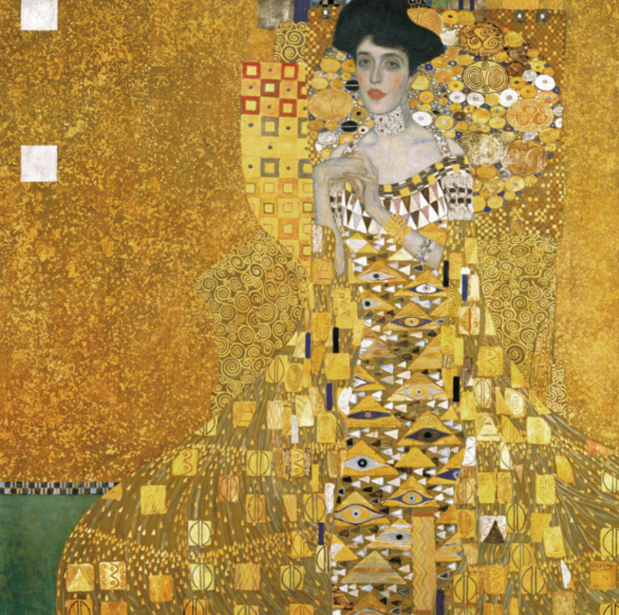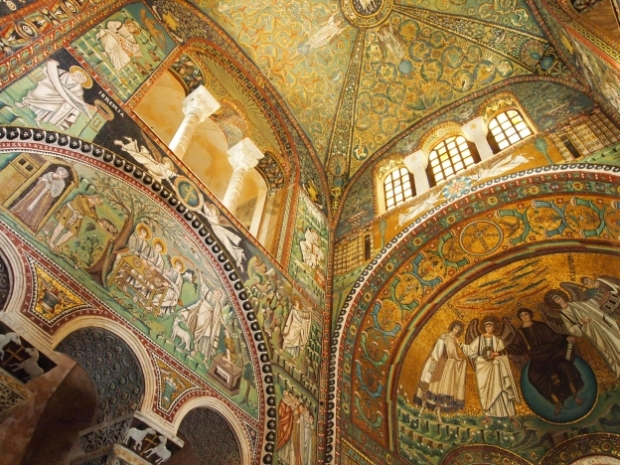Gustav Klimt -‘Adele Bloch-Bauer I’ (1907)
Presented below is the portrait, ‘Adele Bloch-Bauer I’ otherwise known as ‘the woman in gold’, painted by the Austrian painter Gustav Klimt. A dominant artist of the 20th Century, a progenitor of the Vienna secession and Art Nouveau movements formed in 1897 (Payne, 2000) and a member of the Wiener Werkstätte (Brandstätter, 2003).
 Fig.1. Gustav Klimt -‘Adele Bloch-Bauer I (1907) Oil on canvas, 138 x 138cm.
Fig.1. Gustav Klimt -‘Adele Bloch-Bauer I (1907) Oil on canvas, 138 x 138cm.
Klimt distinctively decorated his works through symbolism to convey hidden ideas (Aurier, 2006) of which were influenced by the organic forms of the earlier Arts and Crafts movement (Klimt museum, 2018). His portrayal of Adele Bloch-Bauer incorporates the use of geometric shapes contrasted with soft circular free flowing lines; this could be to convey her wealth and power whilst simultaneously representing her femininity.
 Fig.2. The Church of San Vitale, Klimt took influence from the Byzantine mosaics, Ravenna, Italy.
Fig.2. The Church of San Vitale, Klimt took influence from the Byzantine mosaics, Ravenna, Italy.
The painting of the young Jewish woman was commissioned by her husband- a successful industrialist, (Lauder, 2006) thus contextualising the decadence of the portrait. The oil painting was from Klimt’s “golden period” (Vergo, 2001) and was his response to the Byzantine mosaics in Ravenna, Italy. This influence is apparent through the richly decorated attire and use of gold leaf, both of which are connotative to opulence and wealth suggesting the subject is of great importance. Additionally, Kallir (1986) stated that the Vienna succession artists’ turned to the recently established middle class for sponsorships, with Brandstätter (2003) claiming the artistic renewal enticed the social support of the liberal minded upper classes. In which case would explain the elaborate colour palette and splendour in which Klimt represented Bloch-Bauer.

Fig.3. A Pastiche painting by myself of Gustav Klimt’s ‘The Kiss’ (1907) that depicts Klimt’s “golden period” and represents the influence of the Byzantine mosaics on Klimt’s work.
When considering the cultural significance of the clothing, it is clear to see the impact of ancient civilizations on the aesthetics of the portrait. The use geometric shapes and the eyes on the dress demonstrates Egyptian influences with repeat coils showing Klimt’s influence from Mycenaean art (Whitford, 1990). Schweiger (1984) stated the importance of antique Egyptian collections held at the Palais Stocler as part of the Wiener Werkstätte.
To add to this, Klimt designed dresses as part of the dress reform movement whilst at Wiener Werkstätte (Fig.5), following the medical dangers of tight corsets and the development towards female liberation (Partsch, 1994). The ornamental attributes of Klimt’s fabric designs are also evident when analyzing ‘Adele Bloch-Bauer I’ and Neret (2015) claims the decorative designs were used to ‘enhance the monumental dignity’ of the subjects.
Fig.4. Emilie Flöge in dresses from a series of loose dresses designed jointly by herself and Gustav Klimt at the Wiener Werkstätte (1906).
Furthermore, from 1905 onwards, hand printed and painted textiles adorned the fashions (Brandstätter, 2003). As conveyed in Klimt’s portrait, the use of flat geometric patterns derived from stylization based on natural forms and abstraction is apparent (Völker, 1990). It is clear to see the impact the Vienna succession had on Klimt’s depiction of Adele Bloch-Bauer. It could be argued that the portrait indicates the high social status and cultural capital of the subject through the use of ornamental decoration to convey her privileged upbringing and sense of the awareness regarding culture (Gustav Klimt.com, 2011).
Word count: 470
References
Aurier, G.A. (2006) Symbolism in Painting: Paul Gauguin. In: Lewer, D (Ed) Blackwell Anthologies in Art History Post- Impressionism to World War 2. Oxford: Blackwell Publishing. p.76.
Brandstätter, C. (2003) Wonderful Wiener Werkstätte Design in Vienna 1903-1932. London: Thames & Hudson.
Gustav Klimt. Com (2011) Portrait of Adele Bloch Bauer I, 1907 by Gustav Klimt. [Online]. Available at: https://www.gustav-klimt.com/Portrait-Of-Adele-Bloch-Bauer-1.jsp#prettyPhoto [Accessed 24 April 2018].
Kallir, J. (1986) Viennese Design and the Wiener Werkstätte. New York: Galerie St. Etienne/ George Braziller.
Lauder, R. (2006) The Charlie Rose Show : Transcripts A Look at Gustav Klimt`s Masterpiece, Adele Bloch-Bauer I, and a Discussion With Its New Owner, Ronald Lauder. [transcript] Waltham. 5th September. Available at: https://search-proquest-com.proxy.library.dmu.ac.uk/docview/190761571/fulltext/1B52A95BE63B4FBAPQ/1?accountid=10472 [Accessed 24 April 2018].
Neret, G. (2015) Klimt. Germany: Taschen.
Partsch, S. (1994) Gustav Klimt Painter Of Women. New York: Prestel.
Payne, L. (2000) Essential Klimt. London: Parragon.
Schweiger, W.J. (1984) Wiener Werkstätte. London: Thames & Hudson.
Vergo, P (2001) Between Modernism and Tradition: The importance of Klimt’s Murals and Figure Paintings. In: Bailey, C.B. (Ed) Gustav Klimt Modernism in the Making. New York: Harry N. Abrams Inc. p.19.
Völker, A. (1990) Textiles of the Wiener Werkstätte 1910-1932. London: Thames & Hudson.
Whitford, F. (1990) Klimt. London: Thames & Hudson.
Image references
FIG.1
Klimt Museum (2018) Bildnis der Adele Bloch-Bauer I 1907. [Online image]. Available at: http://www.klimt.com/en/gallery/women/klimt-bildnis-adele-bloch-bauer1-1907.ihtml [Accessed 29 March 2018].
FIG.2
Italy Magazine (2008) The three best place to view mosaic art in Ravenna [Online image]. Available at: http://www.italymagazine.com/featured-story/three-best-places-view-mosaic-art-ravenna [Accessed 29 March 2018].
FIG.4
Klimt, G. (1906) Emily Flöge. [Photograph]. In: Brandstätter, C. (2003) Wonderful Wiener Werkstätte Design in Vienna 1903-1932. London: Thames & Hudson.
FIG.5
Wiener Werkstätte archive (1911) Wiener Werkstätte ladies’ dress [Photograph]. In: Brandstätter, C. (2003) Wonderful Wiener Werkstätte Design in Vienna 1903-1932. London: Thames & Hudson.

